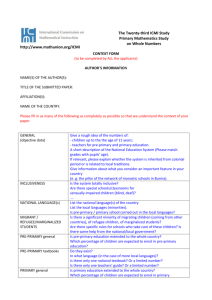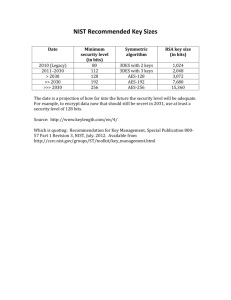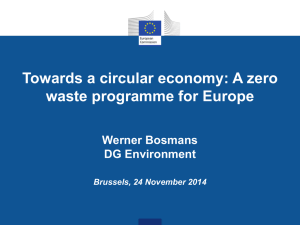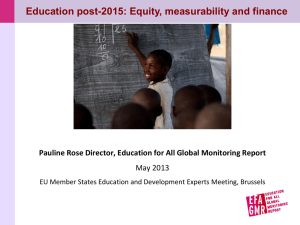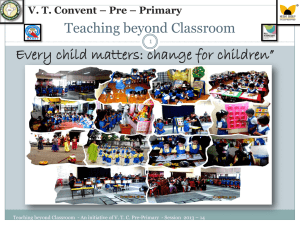Policy Paper Education for All Global Monitoring Report
advertisement
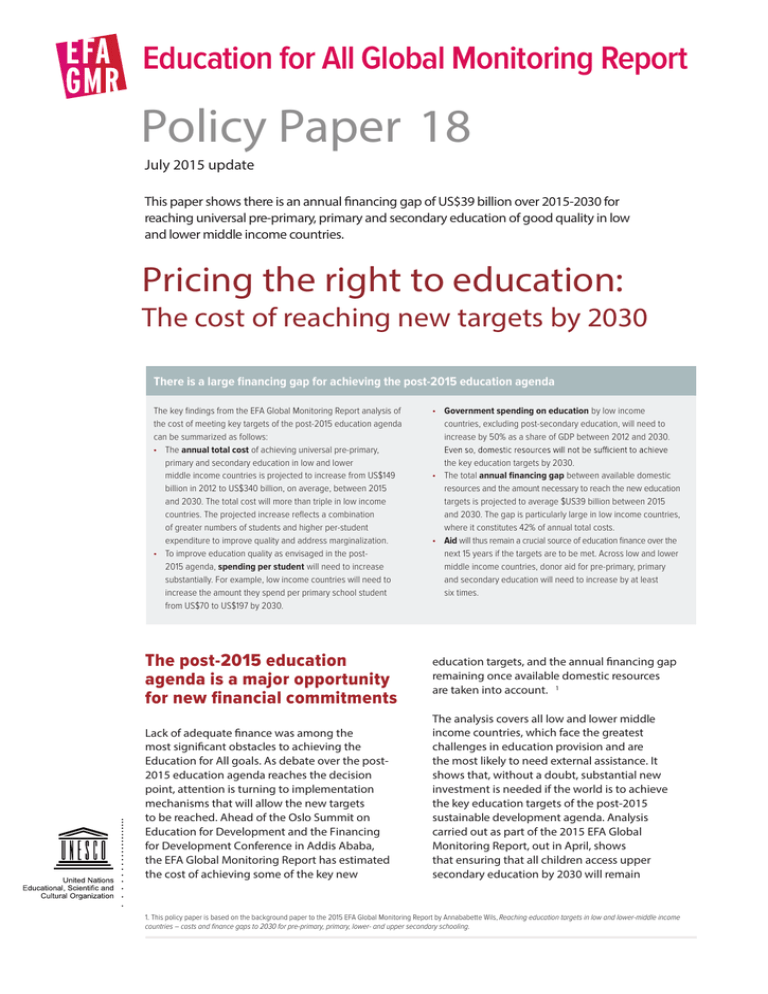
Education for All Global Monitoring Report Policy Paper 18 July 2015 update This paper shows there is an annual financing gap of US$39 billion over 2015-2030 for reaching universal pre-primary, primary and secondary education of good quality in low and lower middle income countries. Pricing the right to education: The cost of reaching new targets by 2030 There is a large financing gap for achieving the post-2015 education agenda The key findings from the EFA Global Monitoring Report analysis of the cost of meeting key targets of the post-2015 education agenda can be summarized as follows: • The annual total cost of achieving universal pre-primary, primary and secondary education in low and lower middle income countries is projected to increase from US$149 billion in 2012 to US$340 billion, on average, between 2015 and 2030. The total cost will more than triple in low income countries. The projected increase reflects a combination of greater numbers of students and higher per-student expenditure to improve quality and address marginalization. • To improve education quality as envisaged in the post2015 agenda, spending per student will need to increase substantially. For example, low income countries will need to increase the amount they spend per primary school student from US$70 to US$197 by 2030. The post-2015 education agenda is a major opportunity for new financial commitments Lack of adequate finance was among the most significant obstacles to achieving the Education for All goals. As debate over the post2015 education agenda reaches the decision point, attention is turning to implementation mechanisms that will allow the new targets to be reached. Ahead of the Oslo Summit on Education for Development and the Financing for Development Conference in Addis Ababa, the EFA Global Monitoring Report has estimated the cost of achieving some of the key new • Government spending on education by low income countries, excluding post-secondary education, will need to increase by 50% as a share of GDP between 2012 and 2030. the key education targets by 2030. • The total annual financing gap between available domestic resources and the amount necessary to reach the new education targets is projected to average $US39 billion between 2015 and 2030. The gap is particularly large in low income countries, where it constitutes 42% of annual total costs. • Aid will thus remain a crucial source of education finance over the next 15 years if the targets are to be met. Across low and lower middle income countries, donor aid for pre-primary, primary and secondary education will need to increase by at least six times. education targets, and the annual financing gap remaining once available domestic resources are taken into account. 1 The analysis covers all low and lower middle income countries, which face the greatest challenges in education provision and are the most likely to need external assistance. It shows that, without a doubt, substantial new investment is needed if the world is to achieve the key education targets of the post-2015 sustainable development agenda. Analysis carried out as part of the 2015 EFA Global Monitoring Report, out in April, shows that ensuring that all children access upper secondary education by 2030 will remain 1. This policy paper is based on the background paper to the 2015 EFA Global Monitoring Report by Annababette Wils, Reaching education targets in low and lower-middle income countries – costs and finance gaps to 2030 for pre-primary, primary, lower- and upper secondary schooling. Policy Paper 18 Education for All Global Monitoring Report beyond the grasp of the international community unless priorities are re-considered. On current trends, the proportion of 21-yearolds completing upper secondary education will increase from 18% to 26% in low income countries between 2015 and 2030 and from 39% to 52% in lower middle income countries. It will even be a challenge to achieve universal primary education by the new deadline. The EFA Global Monitoring Report analysis shows that, even if rather ambitious assumptions about the growth of domestic expenditure are borne out, external assistance will be called upon to play a bigger role. Such claims for assistance will be in direct competition with claims by other sectors for their targets. The scale of the challenge is acute and highlights the need to set clear financing targets to ensure that past mistakes are not repeated. Which targets do these estimates address? The zero draft of the outcome document for the UN Summit to adopt the post-2015 development agenda, whose fourth goal is to ‘ensure inclusive and equitable quality education and promote lifelong learning opportunities for all’, clearly emphasizes quantifiable targets. Even so, some targets lack an agreed operational definition. For the purpose of this costing exercise, the following interpretations were given to some of the key post-2015 education targets currently proposed; Table 1 shows related parameters. Early childhood care and education By 2030, ensure that all girls and boys have access to quality early childhood development, care and pre-primary education so that they are ready for primary education. The overall objective of all children developing their full potential will be served by diverse interventions, many of which are not educationspecific. For the purpose of this costing exercise, the target has been interpreted to mean that all children will complete one year of pre-primary school. This is equated with a pre-primary gross enrolment ratio of 100% by 2030. Although universal pre-primary education is an objective in itself, it is important to note that pre-primary schooling also helps improve school readiness and subsequent learning outcomes, and thus is crucial for the universal completion of primary and secondary education. Primary and secondary education By 2030, ensure that all girls and boys complete free, equitable and quality primary and secondary education leading to relevant and effective learning outcomes. The costing of this target focuses on the achievement of universal primary and secondary education of good quality. The costing exercise takes into account the need for all children to enter school, progress from one grade to the Table 1. Main assumptions in terms of targets and cost parameters Indicator Initial value Target value 37% 100% Primary completion rate 70% 100% Lower secondary completion rate 50% 100% 1. Pre-primary education Pre-primary gross enrolment ratio 2. Primary and secondary education Transition rate to upper secondary education 3. Quality improvement Pupil/teacher ratio Teacher salaries (as multiple of GDP per capita) 4. Equity Markup of per student costs to attract marginalized children (living on <US$2/day) 77% 100% Pre-primary 26 15 Primary 35 29 Lower secondary 27 27 Upper secondary 23 27 e.g. low income countries Pre-primary/primary 4.3 4.4 Lower secondary 6.0 5.6 Upper secondary 6.7 Pre-primary/primary Lower secondary Upper secondary 6.4 20% Not available 30% 40% 2 Education for All Global Monitoring Report next, and achieve these intermediate steps well before the target year if they are to complete both primary and lower secondary education by 2030. By that year, it also assumes that universal transition to upper secondary education will be achieved. Equity By 2030, eliminate gender disparities in education and ensure equal access to all levels of education and vocational training for the vulnerable, including persons with disabilities, indigenous peoples and children in vulnerable situations. In many countries, moving towards universal primary and secondary education and reducing disparity in learning depend on governments targeting resources towards children from marginalized households and communities. For all levels of education considered in this exercise, it is assumed that additional investment will need to be made to ensure education and learning opportunities are provided equitably. Examples of effective interventions include reducing barriers to school access (nutrition programmes, free uniforms, tuition support, etc.); mother-tongue instruction in regions where children do not speak the majority or school language; remote or mobile schools for hard-to-reach children; health interventions against illness (malaria, worms); interventions for children with disabilities; and programmes for children in emergencies. It is assumed that, given the interventions needed to address the disadvantages faced by children living in poverty, per-student costs will need to increase by up to 40%. Literacy and numeracy By 2030, ensure that all youth and at least x% of adults, both men and women, achieve literacy and numeracy. There is limited evidence to help assess the cost of effective adult literacy programmes, with respect both to those that produce sustained gains in literacy skills over time and to scaled-up interventions for reaching all adults with poor literacy skills. The costing exercise considers how to reach universal youth literacy by 2030, which in principle can be achieved through two mechanisms. First, completing primary schooling of good quality should ensure the acquisition of literacy skills, Policy Paper 18 which primary completion currently does not do in many poorer countries. Second, for young people who missed out on formal education, literacy can be acquired through second-chance education programmes. Given the speed with which universal completion of good quality primary education needs to be achieved to meet the targets, the first mechanism plays a more substantive role in the drive for universal youth literacy. Education facilities By 2030, build and upgrade education facilities that are child, disability and gender sensitive and provide safe, non-violent, inclusive and effective learning environments for all. Teachers By 2030, increase by x% the supply of qualified teachers, including through international cooperation for teacher training in developing countries, especially LDCs and SIDS. For all education levels, this paper assumes that some core standards of school quality are necessary to improve learning. Several improvements to school quality that have been found to be important facilitators of learning are reflected in the assumptions of the costing exercise. ■■ At the pre-primary level, there should be no more than 20 students per teacher; at the primary level, the respective figure is 40. The model recognizes that pupil/teacher ratios fall as countries become wealthier, and assumes that countries will gradually converge at a lower global average over time. For example, it is projected that the average ratio in primary education will be 29 students per teacher by 2030. ■■ There are large differences between countries in terms of teacher salaries. Expressed in terms of multiples of GDP per capita, salaries tend to be higher in poorer countries because relevant skills are scarce. The model assumes that there is a long term relationship between teacher salaries and GDP per capita, and that countries will gradually converge at a global average. Calculation of the long term relationship is based on the 50% of countries that pay teachers more. This is to ensure that pay is sufficient to attract the best candidates to the profession. 3 Education for All Global Monitoring Report ■■ The number of new classrooms to be constructed is based on two assumptions: there will be one classroom per teacher; and old classrooms will need to be replaced. New classroom construction is spread over ten years. The cost of each classroom is equal to a base construction cost multiplied by a durable furniture cost. A maintenance cost of 1.5% is also assumed. ■■ One-quarter of recurrent expenditure is allocated for purposes other than teacher salaries. This assumption covers a wide range of cost items to improve quality, ranging from instructional materials to teacher training and school management reforms. This exercise does not take into account objectives in the currently proposed post-2015 education targets related to tertiary education, skills for work, adult literacy and scholarships.2 The analysis builds on, and is broadly comparable with, the costing exercise carried out for the 2010 EFA Global Monitoring Report. However, there are several differences, two of which have an impact on the headline figures (Box 1). The base scenario The base scenario of this costing exercise assumes, first, that the targets will be reached by 2030; second, that GDP growth rates up to 2016 follow IMF projections and after that converge at a long term average of 5%; and, third, that tax ratios as a share of GDP and the share of budgets allocated to education increase at a declining rate. Providing universal pre-primary, primary and secondary education by 2030 will cost US$340 billion per year In absolute terms, the annual total cost of universal pre-primary, primary and secondary education in low income countries is projected to more than triple, from US$14 billion in 2012 to an average of US$50 billion between 2015 and 2030. In lower middle income countries, costs Policy Paper 18 Box 1. Relationship to the 2010 EFA Global Monitoring Report cost estimate The 2010 EFA Global Monitoring Report estimated an annual financing gap of US$16 billion per year, equivalent to 1.5% of GDP, for the 46 poorest countries to achieve universal primary education between 2008 and 2015. The annual financing gap for achieving universal lower secondary education was estimated at US$25 billion over this period. The methodology behind the 2010 estimate has been followed closely in this policy paper. In addition to the fact that the current exercise also costs universal upper secondary education, there are two main differences between the two exercises, which are worth noting because of their potential impact on comparability: • Coverage has expanded from 46 low income countries (according to the 2007 World Bank definitions) to all 82 low and lower middle income countries (per the 2013 World Bank definitions). This is expected to increase the financing gap, although less than proportionately, as the countries added are closer to the targets. • The time horizon for realizing the agenda has been extended from an 8-year period (2008-2015) to a 16-year period (2015-2030). This is expected to reduce the annual financing gap estimate, as the costs are spread over twice as many years. In addition, countries have moved closer to the targets over the past five years, which also reduces the total cost. Other assumptions in this model with a smaller impact on the estimates include the following: • The pre-primary education gross enrolment ratio target is 100%; in the 2010 estimate, it was 52%. • The target for primary and lower secondary education is universal completion with benchmark values based on completion rates using household surveys; in the 2010 estimate, the target was universal education with benchmark values based on enrolment rates using administrative data. • The teacher salary target varies by country, taking into account countries’ respective starting points; in the 2010 estimate, the target was fixed (e.g. it was 4.5 times GDP per capita for sub-Saharan Africa at the primary education level and 3.5 elsewhere). • The share of non-salary items in total recurrent expenditure is 25%; in the 2010 estimate, it was 33% in primary and 40% in lower secondary education. • The proportion of children marginalized in each country is related to the share of the population living on less than US$2 a day; in the 2010 estimate, it was related to the young adult illiteracy rate. • The additional cost for marginalized children was calculated only for the estimated proportion of marginalized children who were not in school; in the 2010 estimate, an additional cost was assumed for all marginalized children. 2. Later in 2015, the EFA Global Monitoring Report will extend its estimate to include the cost of achieving upper secondary education. 4 Policy Paper 18 Education for All Global Monitoring Report enrolled will need to increase. In particular, the number enrolled in pre-primary education will more than double by 2030 overall, but will increase more than fivefold in low income countries (from 5 million to 28 million). Primary enrolment will grow by 58 million, or just 14%, as many countries are close to the target, while the relevant cohort will shrink in some, mainly lower middle income, countries. Lower secondary enrolment will increase by over 50% and will more than double in low income countries. Upper secondary enrolment will need to increase by almost five times in low income countries (from 18 to 82 million) (Table 3a). are higher overall due to their larger population and level of GDP per capita, and the annual total cost is projected to more than double, from US$134 billion in 2012 to an average of US$289 billion over 2015–2030. Across both low and lower middle income countries, the total cost of providing universal pre-primary, primary and secondary education will total US$340 billion, on average, between 2015 and 2030 (Table 2). In relative terms, the total cost of delivering universal pre-primary, primary and secondary education will need to increase across low and lower middle income countries from 3.5% to 6.3% of GDP between 2012 and 2030. However, the increase will be far higher in low income countries, where the cost will need to almost triple as a percentage of GDP over the period. Second, expenditure per student will grow considerably as a result of efforts to improve quality. Overall expenditure per student will need to triple in pre-primary (from US$258 to US$854) and more than double in primary education (from US$195 to US$403). The cost per primary education student in low income countries will need to increase from US$70 to US$197 (Table 3b). These changes are mostly the result of falling pupil/teacher ratios in preprimary and of higher teacher salaries at the pre-primary and primary levels. Absolute costs in lower middle income countries are higher because GDP per capita is higher. Of the total cost, 84% is recurrent expenditure and 11% capital expenditure. The cost of catering to the marginalized amounts to 5% of the overall total but rises to 8% in low income countries and exceeds 12% in some of the poorest countries, such as Burundi, Mali and Niger. The increase in total cost reflects two factors. First, the number of children and adolescents Table 2. Annual total cost by education level, US$ billion, 2012 and 2015–2030 (average) Low income countries Lower middle income countries Low and lower middle income countries 2012 2015–2030 average 2012 2015–2030 average 2012 Pre-primary 0.4 4.4 4.4 26.8 4.8 31.2 Primary 7.3 19.9 60.8 109.5 68.1 129.4 Lower secondary 3.6 11.6 34.5 70.2 38.0 81.8 Upper secondary 3.1 14.5 34.5 82.7 37.7 97.1 14.4 50.4 134.2 289.2 148.6 339.5 Total 2015–2030 average Table 3. Number of students and expenditure per student by level, 2012 and 2030 (projection) Low income countries Lower middle income countries Low and lower middle income countries a. Number of students, millions 2012 2030 2012 2030 5 28 26 57 31 85 Primary 127 163 290 313 418 476 Lower secondary 29 70 125 172 155 242 Upper secondary 18 82 87 184 105 266 Pre-primary 2012 2030 b. Expenditure per student, weighted average, US$ per year (2012 constant prices) Pre-primary 2012 2030 2012 2030 2012 2030 117 421 286 1069 258 854 Primary 70 197 250 510 195 403 Lower secondary 144 284 339 639 301 536 Upper secondary 394 367 823 811 751 675 5 Education for All Global Monitoring Report Government spending must rise to cover the cost of meeting new education targets For the purpose of this paper, it is assumed that governments will increase tax revenue as a share of GDP, and the share of the budget allocated to education will exceed 20%. The combined effect will be to increase domestic public expenditure on pre-primary, primary and secondary education from 2.6% to 3.9% of GDP in low income countries excluding aid. Note that these countries increased the share of GDP dedicated to pre-primary, primary and secondary education by 0.8 percentage points between 1999 and 2012. Lower middle income countries will need to increase their domestic public expenditure on pre-primary, primary and secondary education from 3.3% to 3.9% of GDP between 2012 and 2030 excluding aid. The financing gap will not be filled without increased donor aid Many countries are unlikely to increase their public education expenditure to the levels required to cover the total cost of meeting the targets. The average annual financing gap remaining across all low and lower middle income countries between 2015 and 2030 is estimated at US$39 billion ( Table 4). Once prospects for additional domestic resources have been taken into account, the annual gap totals US$21 billion in low income countries, or 42% of the total cost, and US$18 billion in lower middle countries, or 6% of the total cost (Figure 1). This financing gap is equivalent to 1.6% of GDP across all countries. Current aid levels only cover a small part of the gap. In low income countries, development assistance for basic and secondary education amounts to US$3 billion and would therefore need to increase sevenfold to fill the gap. Part of that gap could be covered if donors reallocated some of the US$2.8 billion of aid to education they give to low and lower middle income countries to fund postsecondary education. Likewise, part of the gap could be covered by reallocating aid that is currently funding education in upper middle income countries. Policy Paper 18 Table 4. Financing gap, US$ billion (2012 constant prices) Low income countries Lower middle income countries Low and lower middle income countries Total cost, 2012 14.4 134.2 148.6 Total cost, 2015–2030 (average) 50.5 289.4 339.9 Increase in total cost 36.1 155.1 191.2 Financing gap, 2015–2030 (average) 21.0 18.4 39.5 Lower middle income countries are generally much less dependent on external finance. However, there is considerable variation within this group, with some countries still requiring significant external support to meet projected costs. For example, external finance would need to cover the majority of the increase in the total cost in Côte d’Ivoire and Senegal. Across low and lower middle income countries, aid for pre-primary, primary and secondary education would need to increase by at least six times. The required increase could be lower if other external sources of financing stepped in to fill part of the gap. Analysis by the EFA Global Monitoring Report also shows that the entire gap could be filled if the OECD Development Assistance Committee (DAC) members and selected non-DAC donors (i.e. Brazil, China, India, Kuwait, Qatar, the Russian Federation, Saudi Arabia, South Africa and the United Arab Emirates) dedicated 0.7% of their gross national income to aid, and allocated 10% of their aid to education (from pre-primary through to the upper secondary level). However, as an example, among 15 European Union member states who pledged in 2005 to allocate 0.7% of their gross national income to aid only four have done so: the United Kingdom, Denmark, Luxembourg and Sweden. While the overall financing gap in education may appear large, it is equal to just 8 days of annual global military expenditure, which totalled US$1.75 trillion in 2013. 6 Education for All Global Monitoring Report Figure 1. Breakdown of annual resource needs to achieve universal pre-primary, primary and lower secondary education, 2015–2030 a. Low income countries 60 Current aid US$ billion (2012 constant prices) 50 40 20 21.0 Financing gap 4.9 Additional sources from education prioritization 12.2 Additional sources from GDP growth 12.4 Current spending Remaining shortfall 10 0 Low income countries b. Lower middle income countries 350 Current aid 3.2 US$ billion (2012 constant prices) 300 250 200 18.4 30.7 Financing gap Additional sources from education prioritization 113.1 Additional sources from GDP growth 127.2 Current spending 15.2 Remaining shortfall 150 100 50 Constrained external finance. If external assistance increased roughly in line with overall GDP growth, the targets would not be met until around 2070. This scenario presents the penalty for not acting now to make these education targets an international priority. 3.0 18.0 30 Policy Paper 18 0 Lower middle income countries Alternative scenarios suggest that other options are not attractive To assess the sensitivity of these cost projections, alternative scenarios were examined. Two extreme scenarios show the impact of the speed with which the targets are achieved. Achieve the targets by 2020. Moving the target date forward by ten years results in large cost increases because schools and classrooms need to be built more quickly, even though there is less time for GDP to grow and budgets to be reallocated to absorb some of the higher costs. Overall, the financing gap would be 72% higher than in the base scenario. Better quality financing data is needed The main purpose of a global costing exercise is to help establish the parameters of the financial envelope required for achieving selected targets. It cannot and should not substitute for detailed estimates drawn up at the national level. The cost estimates reported here for low and lower middle income countries are based on the most recent data available (Box 2). They should still be indicative of the size of the financing gap faced by most such countries. Two caveats should be kept in mind. First, the quality and coverage of official financing data remain lamentably poor. Between 2000 and 2013 only 49% of the data were available for the most basic indicator, public expenditure as percentage of GDP. The situation deteriorates rapidly when more disaggregated information is needed. No financial data are available for Nigeria, the country with the largest out-of-school Box 2. Data sources The costing study has drawn on the most recent data using the following principal sources: • The United Nations World Population Prospects database for information on school age populations and projections of population growth • The UNESCO Institute for Statistics for information on enrolment, student progression rates, teachers, classrooms and education financing • The World Inequality Database on Education for information on attainment rates • The World Bank and International Monetary Fund for information on GDP levels and projections and government revenues These were supplemented by other sources, including national education sector plans. Where no national data were available, regional aggregates were used. This means that, despite the best of efforts, there may be significant margins of error in particular countries. 7 Education for All Global Monitoring Report population. It is entirely unknown what it will take to rebuild the education sector in countries that have been damaged by conflict, such as the Syrian Arab Republic. Second, strong national policies are needed to accompany sufficient financing. The same level of spending may produce very di erent results in di erent countries because of policies and practices pertaining to equity, efficiency and e ectiveness. Even so, given the level of ambition of the proposed SDG agenda, the lack of adequate financing will be the largest obstacle in poorer countries. Conclusion The costing of key post-2015 education targets sharpens understanding of the financial challenges ahead. Achieving universal preprimary, primary and secondary education of good quality in the next 15 years requires external partners to provide US$39 billion per year to low and lower middle income countries. This is what is at stake in Oslo and Addis Ababa and the coming months. Policy Paper 18 Implementation of the new sustainable development agenda underscores the need for explicit commitments to be made by governments and donors. This is especially the case if major education targets are to be realized: ■ Low income countries will need to increase spending in terms of GDP on pre-primary, primary and secondary education by 50%. ■ In order to fill the gap, OECD DAC donors would need to increase the volume of aid for pre-primary, primary and secondary education in low and lower middle income countries by at least six times. Part of this can be covered by better targeting of aid currently going to upper middle income countries and/ or to post-secondary education. ■ The gap would be filled if DAC and selected non-DAC donors spent (i) 0.7% of their gross national income on aid and (ii) 10% of their aid portfolio on basic and secondary of annual global military expenditure. EFA Global Monitoring Report c/o UNESCO 7, place de Fontenoy 75352 Paris 07 SP, France Tel: +33 (1) 45 68 10 36 Fax: +33 (1) 45 68 56 41 www.efareport.unesco.org Developed by an independent team and published by UNESCO, the Education for All Global Monitoring Report is an authoritative reference that aims to inform, influence and sustain genuine commitment towards Education for All. © UNESCO ED/EFA/MRT/2015/PP/18/REV3 8
